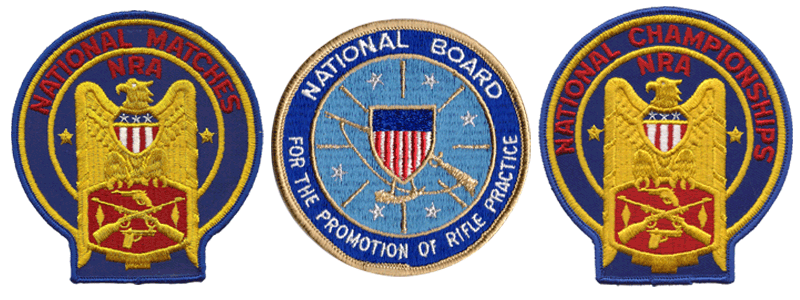
THE NATIONAL MATCHES
The National Matches were established by Act of Congress in 1903. The first matches were held in 1903, with participation being limited to teams from the Regular Services and State National Guard organizations.
With the passage of the National Defense Act in 1916, participation of civilian teams from each state was also authorized, and the Small Arms Firing School became an important part of the National Match program in 1918. The National Championships of the National Rifle Association have been an important parts of the National Match program from the beginning. The culminating features in the various classes of firing are the National Trophy Individual and Team Rifle and Pistol Matches.
The National Matches are conducted with the approval of the Secretary of the Army and under the supervision of the National Board for the Promotion of Rifle Practice. Definite rules and regulations governing the National Rifle and Pistol Matches, for which are awarded the National Trophies, medals, and other badges, are given in AR 920-30/NAVPERS 15880/AFR 34-18/NAVMC 1102 (1957). All conflicting regulations previously issued are revoked and any points not covered by said regulation will follow the provisions of appropriate Field Manuals or will be covered by the decisions of the Executive Officer, National Matches.
It will simplify matters for all competitors if they will thoroughly acquaint themselves with the provisions of the regulations referred to above. A copy of these regulations will be available to each team captain upon arrival at Camp Perry.
Source: 1957 National Matches Program
NRA National Championships
The National Matches were established by Act of Congress in 1903. The first matches were held at Sea Girt, N.J. The Regulars fared badly in this first national competition — the New York National Guard won over New Jersey by 86 points while the Marines placed sixth, the Army seventh and the Navy thirteenth in the field of 15 team entries.
In 1907 the National Matches were moved to Camp Perry, Ohio, and another American tradition was in the making.
No National Matches were held in 1916, 1917, or 1918, but the excellent ranges at Camp Perry were fully utilized in training marksmanship instructors. The group that set up this training program were, themselves, graduates of the National Match training programs. Out of the lessons learned and the procedures developed by this group came the revision of small arms training manuals after the war.
The Navy conducted the National Matches in 1919 at its range at Caldwell, N.J., with Navy and Marine personnel operating the range. These matches saw the first state teams attend at government expense and the introduction of smallbore .22 caliber matches in the National Championships.
With the return of the National Matches to Camp Perry in 1920, and the addition of the Small Arms Firing Schools to the National Championships program, pistol competition began to grow. The 3-stage — slow, timed and rapid (National Match Course) — had been adopted and the "Camp Perry Police Course," fired at 25 yds., became popular. Police marksmanship training increased until in 1936 the Los Angeles Police Pistol Team won the National Pistol Championship.
During the period from 1920 to 1940 great strides were made through the National Match program. Among these were:
- The steady development of improved service ammunition by both commercial and government manufacturers.
- Continuing refinement in manufacturing processes on the service rifle at government armories.
- The development of improved sights and stocks.
- Constant improvement in the standards of rifle marksmanship in the regular service.
No National Matches were held during World War II, but the marksmanship techniques already developed were valuable assets to our military training programs during the war.
During World War II Camp Perry was used as a Prisoner of War camp and hundreds of tarpaper "hutments" dotted the area.
Competitors returning to Camp Perry for the pistol and smallbore rifle matches in 1946 well remember the condition of the post following the war. No National Matches were held in 1948 and 1950 and Camp Perry was not used again until 1953.
As with the muzzle loaders at Creedmoor, the Krag Jorgensens at Sea Girt and the Springfields at Camp Perry, the National Championships through the tests of competition, also helped the Garand (M-1 Rifle), and the M-14 Rifle into precision shooting instruments. The skills gained on the ranges at the National Matches are now, as in the past, contributing significantly to the skills of many of our rifleman in Vietnam.
Due to reasons of economy and the varied requirements of the Vietnam situation the Department of Defense, in 1968, withdrew military financial and troop support of the National Matches. However, for the past 3 years and again this year, the tradition of the National Matches found in 1903, is being carried on by the NRA who, with the cooperation of the State of Ohio and the many NRA volunteers at Camp Perry, will conduct the NRA Rifle and Pistol Championships, four of the National Trophy Matches, a Police Firearms Instructor School and the NRA Instructor-Junior School.
Match equipment which was originally acquired to support the National Matches is made available by the National Board for the Promotion of Rifle Practice to aid in operations of the National Rifle and Pistol Championships this year.
Source: 1971 NRA National Rifle & Pistol Championships Program
- 1950
San Francisco
California - 1951
San Francisco
California - 1952
Jacksonville
Florida - 1954
Camp Perry
Ohio - 1955
Camp Perry
Ohio - 1956
Camp Perry
Ohio - 1957
Camp Perry
Ohio - 1959
Camp Perry
Ohio - 1961
Camp Perry
Ohio - 1962
Camp Perry
Ohio - 1963
Camp Perry
Ohio - 1964
Camp Perry
Ohio - 1970
Camp Perry
Ohio - 1971
Camp Perry
Ohio - 1972
Camp Perry
Ohio